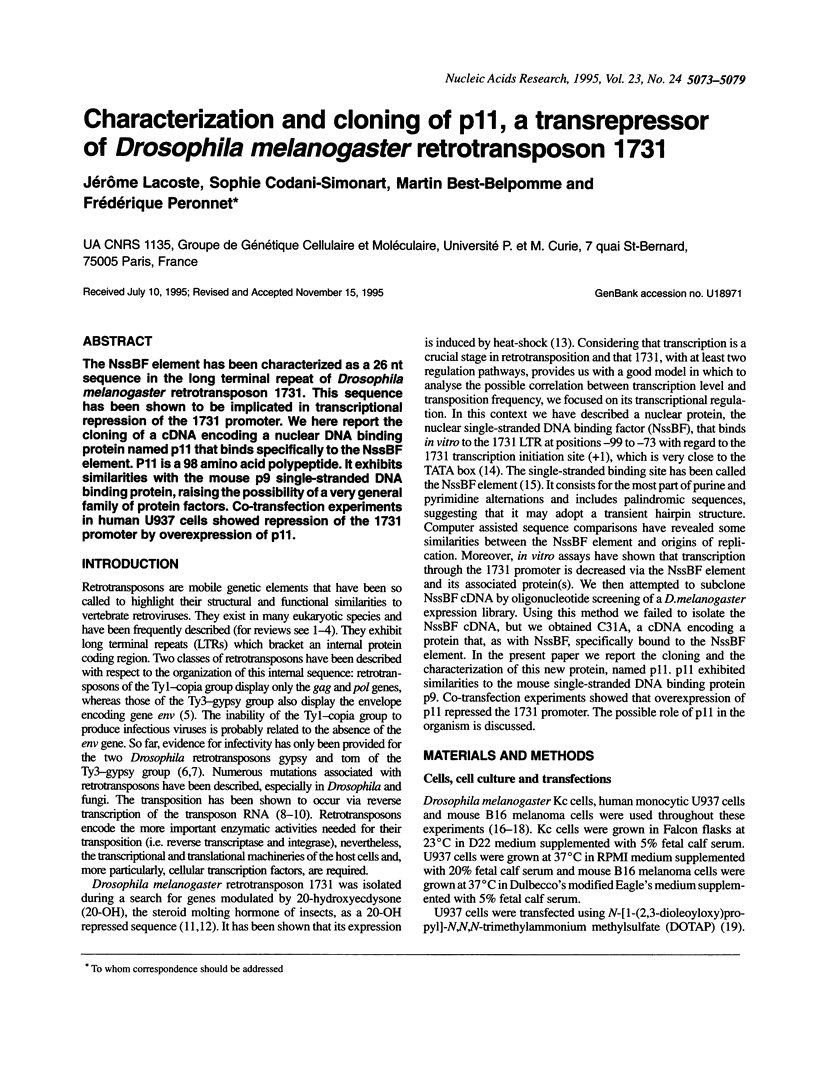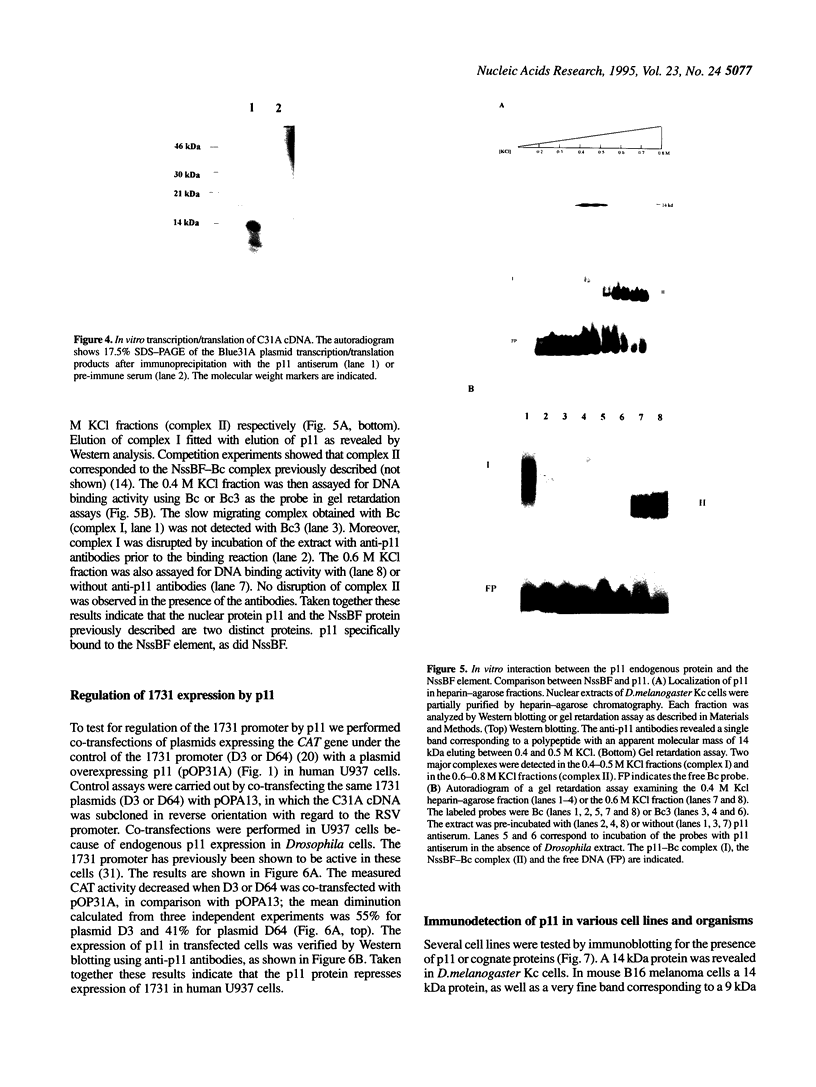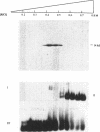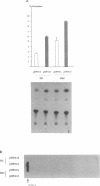Abstract
The NssBF element has been characterized as a 26 nt sequence in the long terminal repeat of Drosophila melanogaster retrotransposon 1731. This sequence has been shown to be implicated in transcriptional repression of the 1731 promoter. We here report the cloning of a cDNA encoding a nuclear DNA binding protein named p11 that binds specifically to the NssBF element. P11 is a 98 amino acid polypeptide. It exhibits similarities with the mouse p9 single-stranded DNA binding protein, raising the possibility of a very general family of protein factors. Co-transfection experiments in human U937 cells showed repression of the 1731 promoter by overexpression of p11.
Full text
PDF






Images in this article
Selected References
These references are in PubMed. This may not be the complete list of references from this article.
- Ballard D. W., Philbrick W. M., Bothwell A. L. Identification of a novel 9-kDa polypeptide from nuclear extracts. DNA binding properties, primary structure, and in vitro expression. J Biol Chem. 1988 Jun 15;263(17):8450–8457. [PubMed] [Google Scholar]
- Boeke J. D., Garfinkel D. J., Styles C. A., Fink G. R. Ty elements transpose through an RNA intermediate. Cell. 1985 Mar;40(3):491–500. doi: 10.1016/0092-8674(85)90197-7. [DOI] [PubMed] [Google Scholar]
- Codani-Simonart S., Lacoste J., Best-Belpomme M., Fourcade-Peronnet F. Promoter activity of the 1731 Drosophila retrotransposon in a human monocytic cell line. FEBS Lett. 1993 Jul 5;325(3):177–182. doi: 10.1016/0014-5793(93)81068-b. [DOI] [PubMed] [Google Scholar]
- Dessen P., Fondrat C., Valencien C., Mugnier C. BISANCE: a French service for access to biomolecular sequence databases. Comput Appl Biosci. 1990 Oct;6(4):355–356. doi: 10.1093/bioinformatics/6.4.355. [DOI] [PubMed] [Google Scholar]
- Echalier G. Drosophila retrotransposons: interactions with genome. Adv Virus Res. 1989;36:33–105. doi: 10.1016/s0065-3527(08)60582-5. [DOI] [PubMed] [Google Scholar]
- Echalier G., Ohanessian A. Isolement, en cultures in vitro, de lignées cellulaires diploïdes de Drosophila melanogaster. C R Acad Sci Hebd Seances Acad Sci D. 1969 Mar 31;268(13):1771–1773. [PubMed] [Google Scholar]
- Edelmann W., Kröger B., Goller M., Horak I. A recombination hotspot in the LTR of a mouse retrotransposon identified in an in vitro system. Cell. 1989 Jun 16;57(6):937–946. doi: 10.1016/0092-8674(89)90332-2. [DOI] [PubMed] [Google Scholar]
- Fieck A., Wyborski D. L., Short J. M. Modifications of the E.coli Lac repressor for expression in eukaryotic cells: effects of nuclear signal sequences on protein activity and nuclear accumulation. Nucleic Acids Res. 1992 Apr 11;20(7):1785–1791. doi: 10.1093/nar/20.7.1785. [DOI] [PMC free article] [PubMed] [Google Scholar]
- Finnegan D. J. Eukaryotic transposable elements and genome evolution. Trends Genet. 1989 Apr;5(4):103–107. doi: 10.1016/0168-9525(89)90039-5. [DOI] [PubMed] [Google Scholar]
- Fourcade-Peronnet F., Codani-Simonart S., Best-Belpomme M. A nuclear single-stranded-DNA binding factor interacts with the long terminal repeats of the 1731 Drosophila retrotransposon. J Virol. 1992 Mar;66(3):1682–1687. doi: 10.1128/jvi.66.3.1682-1687.1992. [DOI] [PMC free article] [PubMed] [Google Scholar]
- Fourcade-Peronnet F., d'Auriol L., Becker J., Galibert F., Best-Belpomme M. Primary structure and functional organization of Drosophila 1731 retrotransposon. Nucleic Acids Res. 1988 Jul 11;16(13):6113–6125. doi: 10.1093/nar/16.13.6113. [DOI] [PMC free article] [PubMed] [Google Scholar]
- Fry M., Perrino F. W., Levy A., Loeb L. A. Factor D is a selective single-stranded oligodeoxythymidine binding protein. Nucleic Acids Res. 1988 Jan 11;16(1):199–211. doi: 10.1093/nar/16.1.199. [DOI] [PMC free article] [PubMed] [Google Scholar]
- Gaillard C., Strauss F. Sequence-specific single-strand-binding protein for the simian virus 40 early promoter stimulates transcription in vitro. J Mol Biol. 1990 Sep 20;215(2):245–255. doi: 10.1016/S0022-2836(05)80343-2. [DOI] [PubMed] [Google Scholar]
- Garcia-Bustos J., Heitman J., Hall M. N. Nuclear protein localization. Biochim Biophys Acta. 1991 Mar 7;1071(1):83–101. doi: 10.1016/0304-4157(91)90013-m. [DOI] [PubMed] [Google Scholar]
- Grandbastien M. A. Retroelements in higher plants. Trends Genet. 1992 Mar;8(3):103–108. doi: 10.1016/0168-9525(92)90198-d. [DOI] [PubMed] [Google Scholar]
- Guan K. L., Dixon J. E. Eukaryotic proteins expressed in Escherichia coli: an improved thrombin cleavage and purification procedure of fusion proteins with glutathione S-transferase. Anal Biochem. 1991 Feb 1;192(2):262–267. doi: 10.1016/0003-2697(91)90534-z. [DOI] [PubMed] [Google Scholar]
- Heidmann O., Heidmann T. Retrotransposition of a mouse IAP sequence tagged with an indicator gene. Cell. 1991 Jan 11;64(1):159–170. doi: 10.1016/0092-8674(91)90217-m. [DOI] [PubMed] [Google Scholar]
- Jost J. P., Saluz H., Jiricny J., Moncharmont B. Estradiol-dependent trans-acting factor binds preferentially to a dyad-symmetry structure within the third intron of the avian vitellogenin gene. J Cell Biochem. 1987 Sep;35(1):69–82. doi: 10.1002/jcb.240350106. [DOI] [PubMed] [Google Scholar]
- Kim A., Terzian C., Santamaria P., Pélisson A., Purd'homme N., Bucheton A. Retroviruses in invertebrates: the gypsy retrotransposon is apparently an infectious retrovirus of Drosophila melanogaster. Proc Natl Acad Sci U S A. 1994 Feb 15;91(4):1285–1289. doi: 10.1073/pnas.91.4.1285. [DOI] [PMC free article] [PubMed] [Google Scholar]
- Kozak M. Compilation and analysis of sequences upstream from the translational start site in eukaryotic mRNAs. Nucleic Acids Res. 1984 Jan 25;12(2):857–872. doi: 10.1093/nar/12.2.857. [DOI] [PMC free article] [PubMed] [Google Scholar]
- Kuff E. L., Lueders K. K. The intracisternal A-particle gene family: structure and functional aspects. Adv Cancer Res. 1988;51:183–276. doi: 10.1016/s0065-230x(08)60223-7. [DOI] [PubMed] [Google Scholar]
- Lacoste J., Fourcade-Peronnet F. The NssBF element, a sequence of the Drosophila melanogaster retrotransposon 1731 potentially implicated in transcriptional repression and replication. FEBS Lett. 1995 Jan 9;357(3):283–286. doi: 10.1016/0014-5793(94)01373-9. [DOI] [PubMed] [Google Scholar]
- Leventis R., Silvius J. R. Interactions of mammalian cells with lipid dispersions containing novel metabolizable cationic amphiphiles. Biochim Biophys Acta. 1990 Mar 30;1023(1):124–132. doi: 10.1016/0005-2736(90)90017-i. [DOI] [PubMed] [Google Scholar]
- Mukherjee R., Chambon P. A single-stranded DNA-binding protein promotes the binding of the purified oestrogen receptor to its responsive element. Nucleic Acids Res. 1990 Oct 11;18(19):5713–5716. doi: 10.1093/nar/18.19.5713. [DOI] [PMC free article] [PubMed] [Google Scholar]
- Peronnet F., Becker J. L., Becker J., d'Auriol L., Galibert F., Best-Belpomme M. 1731, a new retrotransposon with hormone modulated expression. Nucleic Acids Res. 1986 Nov 25;14(22):9017–9033. doi: 10.1093/nar/14.22.9017. [DOI] [PMC free article] [PubMed] [Google Scholar]
- Ralph P., Moore M. A., Nilsson K. Lysozyme synthesis by established human and murine histiocytic lymphoma cell lines. J Exp Med. 1976 Jun 1;143(6):1528–1533. doi: 10.1084/jem.143.6.1528. [DOI] [PMC free article] [PubMed] [Google Scholar]
- Silagi S. Control of pigment production in mouse melanoma cells in vitro. Evocation and maintenance. J Cell Biol. 1969 Nov;43(2):263–274. doi: 10.1083/jcb.43.2.263. [DOI] [PMC free article] [PubMed] [Google Scholar]
- Singh H., Clerc R. G., LeBowitz J. H. Molecular cloning of sequence-specific DNA binding proteins using recognition site probes. Biotechniques. 1989 Mar;7(3):252–261. [PubMed] [Google Scholar]
- Tanda S., Mullor J. L., Corces V. G. The Drosophila tom retrotransposon encodes an envelope protein. Mol Cell Biol. 1994 Aug;14(8):5392–5401. doi: 10.1128/mcb.14.8.5392. [DOI] [PMC free article] [PubMed] [Google Scholar]
- Traut W., Fanning E. Sequence-specific interactions between a cellular DNA-binding protein and the simian virus 40 origin of DNA replication. Mol Cell Biol. 1988 Feb;8(2):903–911. doi: 10.1128/mcb.8.2.903. [DOI] [PMC free article] [PubMed] [Google Scholar]
- Yoshioka K., Kanda H., Akiba H., Enoki M., Shiba T. Identification of an unusual structure in the Drosophila melanogaster transposable element copia: evidence for copia transposition through an RNA intermediate. Gene. 1991 Jul 22;103(2):179–184. doi: 10.1016/0378-1119(91)90271-c. [DOI] [PubMed] [Google Scholar]
- Ziarczyk P., Best-Belpomme M. A short 5' region of the long terminal repeat is required for regulation by hormone and heat shock of Drosophila retrotransposon 1731. Nucleic Acids Res. 1991 Oct 25;19(20):5689–5693. doi: 10.1093/nar/19.20.5689. [DOI] [PMC free article] [PubMed] [Google Scholar]
- Ziarczyk P., Fourcade-Peronnet F., Simonart S., Maisonhaute C., Best-Belpomme M. Functional analysis of the long terminal repeats of Drosophila 1731 retrotransposon: promoter function and steroid regulation. Nucleic Acids Res. 1989 Nov 11;17(21):8631–8644. doi: 10.1093/nar/17.21.8631. [DOI] [PMC free article] [PubMed] [Google Scholar]
- de Sa C. M., Rollet E., de Sa M. F., Tanguay R. M., Best-Belpomme M., Scherrer K. Prosomes and heat shock complexes in Drosophila melanogaster cells. Mol Cell Biol. 1989 Jun;9(6):2672–2681. doi: 10.1128/mcb.9.6.2672. [DOI] [PMC free article] [PubMed] [Google Scholar]








